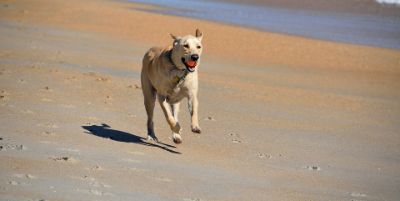Since early 2020, when the COVID-19 pandemic took hold in the United States, one-third of pet parents have reported that their furry family members have become overweight. One of the main culprits is the amount of time their owners are spending at home: While about 20 percent of Americans worked from home prior to 2020, by the end of the year, 71 percent were working from home at least part of the time. All of that extra time at home has made pet owners more available to give their animals treats and snacks throughout the day.

Another reason pets have been putting on the pounds is that during times of COVID-19 restrictions, it has been difficult for pet owners to maintain their usual exercise routines with their pets. Those living in cities might have tried to avoid walking on busy streets. Many dog parks and other recreational areas have been closed. For pets who don’t have their own large, fenced backyard to romp around in, being limited to one or two short walks per day rather than an hour or more playing with other dogs at the park has caused a calorie surplus, particularly if those extra treats are part of the equation.
Dogs and cats aren’t alone in their weight gain. People are also putting on the “quarantine 15.” In one study, nearly half of women and a quarter of men have reported that they’ve experienced weight gain in response to the pandemic. The reasons behind this are many: People tend to eat when they’re stressed, they are able to snack more readily since they are home, in many places the gyms are closed, and working from home often means people are moving around less than they would in a typical office building. This is relevant because overweight pet owners tend to have overweight pets. While there are many factors behind overweight and obesity in humans, in cases where nutrition and a lack of exercise are the culprits, these factors tend to extend to the animals living in a household, too.
While ‘chonky’ dogs and cats are adorable, they can also be less healthy than their svelte counterparts. Having excess fat on their bodies leads to inflammation, which can lead to a wide range of health issues, including diabetes, cancers, pancreatitis, urinary issues, and heart problems. As pets become more and more overweight, physical activity becomes less and less comfortable for them, which exacerbates the problem. Pets who are overweight or obese can have lifespans that are up to two years shorter than their slimmer peers.
While most pet owners think that they would recognize the signs of overweight or obesity in their pets, the survey numbers tell a different story: Veterinarians report that nearly two-thirds of pet parents act surprised or defensive when told that their pets have put on too much weight. When pet owners spend every day with their animals, it can be difficult to see the gradual changes that take place.

For those wanting to know if their pets are too chonky for their own good, asking a veterinarian is the best place to start. If COVID-19 restrictions or financial limitations prohibit that, then there are two tests that people can do in their own homes.
The first is to feel the animal’s ribs. Both dogs and cats should have a thin enough layer of fat on their ribs that their owners can feel them easily when running their hands down the animal’s body with slight pressure. If there is a thicker layer of fat, this is a sign that the pet is getting too heavy. On the other hand, if the ribs are directly under the skin and there is no padding, the pet might be underweight.
The other test is to look at the animal from above. Cats and dogs should both have distinct waistlines. If there is a straight (or bulging) line going from the animal’s shoulders to the base of the tail, then it’s likely that he or she is overweight. The abdomen also gives a clue: Both cats and dogs should have tucked-up abdomens. If a pet has a sagging belly, that is a sign of overweight or obesity.
What should owners do if their pets have put on some weight during the pandemic? Diet and exercise are the most effective ways to achieve weight loss in people and in pets. A veterinarian is the most qualified to give individualized advice, but cutting down on the snacks (or switching to healthier options) and getting plenty of exercise with your pet are excellent first steps. Pet owners should not abruptly change their pet’s diet unless a veterinarian has suggested it, but looking into low-fat or diet cat or dog food might be a reasonable option to reduce weight, too.
Featured Image Courtesy: Pixabay.







